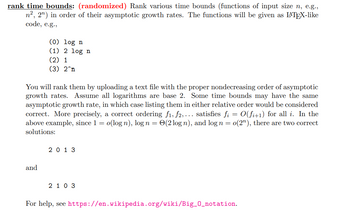
Database System Concepts
7th Edition
ISBN: 9780078022159
Author: Abraham Silberschatz Professor, Henry F. Korth, S. Sudarshan
Publisher: McGraw-Hill Education
expand_more
expand_more
format_list_bulleted
Concept explainers
Question

Transcribed Image Text:rank time bounds: (randomized) Rank various time bounds (functions of input size n, e.g.,
n², 2n) in order of their asymptotic growth rates. The functions will be given as LATEX-like
code, e.g.,
(0) log n
(1) 2 log n
(2) 1
(3) 2^n
You will rank them by uploading a text file with the proper nondecreasing order of asymptotic
growth rates. Assume all logarithms are base 2. Some time bounds may have the same
asymptotic growth rate, in which case listing them in either relative order would be considered
correct. More precisely, a correct ordering f1, f2,... satisfies fi = O(fi+1) for all i. In the
above example, since 1 = o(log n), log n = (2 log n), and log n = o(2"), there are two correct
solutions:
and
2013
2 1 0 3
For help, see https://en.wikipedia.org/wiki/Big_0_notation.
Expert Solution
This question has been solved!
Explore an expertly crafted, step-by-step solution for a thorough understanding of key concepts.
This is a popular solution
Trending nowThis is a popular solution!
Step by stepSolved in 2 steps

Knowledge Booster
Learn more about
Need a deep-dive on the concept behind this application? Look no further. Learn more about this topic, computer-science and related others by exploring similar questions and additional content below.Similar questions
- Question in image Please explain the algorithm with the answer. Python programmingarrow_forwardJava-.Selection and insertion sort 3.a Show steps of selection sort for the given array. You may need to add more rows to the table. Selection Sort Initial value 3 2 7 5 4 8 9 10 1 Search 0 . . . end 3 2 7 5 4 8 9 10 1 Swap index 0 Search 1 . . . end . . . 3.b Show steps of insertion sort for the given array. You may need to add more rows to the table. Insertion Sort Initial value 3 2 7 5 4 8 9 10 1 , first item is sorted 3 2 7 5 4 8 9 10 1 , first 2 items are…arrow_forwardimport numpy as np import torch import matplotlib.pyplot as plt Quiz Preparation Question 1. Write a function that generates a random tensor of n x n (n is the input). The output is the mean of the tensor. = 2, 4, 8, 16, ... 1024 and generate a vector 2. Write a code (for loop) that call that calls the function above with n = M(n). Plot the vector as a function of the log of n. 3. Given an n x m array write a code that replaces every element that is larger than 0.5 with 0.5. 4. The second derivative of a function can be approximated by the finite difference 1 ƒ"(x₂) = 73 (ƒ(£;+1) — 2ƒ(x;) + f(x;-1)) Given a vector f with values f = [f(xo),..., f(n) write a code that computes the approximation to f"(x) 5. The power method is a method to compute the largest eigenvalue of a matrix. Your google search is using this method every time you perform a google search. The method consists of the iteration Vj+1 = Av; || Avi|| where v; is a vector with chosen as a random vector, and A is the matrix…arrow_forward
Recommended textbooks for you
 Database System ConceptsComputer ScienceISBN:9780078022159Author:Abraham Silberschatz Professor, Henry F. Korth, S. SudarshanPublisher:McGraw-Hill Education
Database System ConceptsComputer ScienceISBN:9780078022159Author:Abraham Silberschatz Professor, Henry F. Korth, S. SudarshanPublisher:McGraw-Hill Education Starting Out with Python (4th Edition)Computer ScienceISBN:9780134444321Author:Tony GaddisPublisher:PEARSON
Starting Out with Python (4th Edition)Computer ScienceISBN:9780134444321Author:Tony GaddisPublisher:PEARSON Digital Fundamentals (11th Edition)Computer ScienceISBN:9780132737968Author:Thomas L. FloydPublisher:PEARSON
Digital Fundamentals (11th Edition)Computer ScienceISBN:9780132737968Author:Thomas L. FloydPublisher:PEARSON C How to Program (8th Edition)Computer ScienceISBN:9780133976892Author:Paul J. Deitel, Harvey DeitelPublisher:PEARSON
C How to Program (8th Edition)Computer ScienceISBN:9780133976892Author:Paul J. Deitel, Harvey DeitelPublisher:PEARSON Database Systems: Design, Implementation, & Manag...Computer ScienceISBN:9781337627900Author:Carlos Coronel, Steven MorrisPublisher:Cengage Learning
Database Systems: Design, Implementation, & Manag...Computer ScienceISBN:9781337627900Author:Carlos Coronel, Steven MorrisPublisher:Cengage Learning Programmable Logic ControllersComputer ScienceISBN:9780073373843Author:Frank D. PetruzellaPublisher:McGraw-Hill Education
Programmable Logic ControllersComputer ScienceISBN:9780073373843Author:Frank D. PetruzellaPublisher:McGraw-Hill Education

Database System Concepts
Computer Science
ISBN:9780078022159
Author:Abraham Silberschatz Professor, Henry F. Korth, S. Sudarshan
Publisher:McGraw-Hill Education

Starting Out with Python (4th Edition)
Computer Science
ISBN:9780134444321
Author:Tony Gaddis
Publisher:PEARSON

Digital Fundamentals (11th Edition)
Computer Science
ISBN:9780132737968
Author:Thomas L. Floyd
Publisher:PEARSON

C How to Program (8th Edition)
Computer Science
ISBN:9780133976892
Author:Paul J. Deitel, Harvey Deitel
Publisher:PEARSON

Database Systems: Design, Implementation, & Manag...
Computer Science
ISBN:9781337627900
Author:Carlos Coronel, Steven Morris
Publisher:Cengage Learning

Programmable Logic Controllers
Computer Science
ISBN:9780073373843
Author:Frank D. Petruzella
Publisher:McGraw-Hill Education